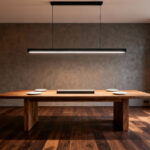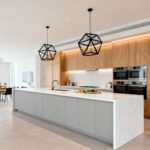Of all the surfaces in your home, your front door does the most emotional heavy lifting. It’s the first hello and the last goodbye. It’s a physical boundary, but it’s also a psychological threshold. As someone who’s spent years studying how our spaces make us feel, I can tell you that a front door isn’t just an entry point—it’s a broadcast to the world, and to yourself, about what lies within.
So, are you sending the right message? Don’t worry if the answer is “I have no idea.” Most people don’t think about it this way. But once you do, you can’t unsee it. Let’s walk through some ideas, big and small, that will help your front door speak your language and give your home’s curb appeal a genuine soul.
1. A Classic and Welcoming Wreath
Let’s start with the OG of front door decor: the wreath. Ever wonder why a simple circle of greenery feels so profoundly welcoming? It’s not just a tradition; it’s psychology. The circular shape, with no beginning and no end, is a universal symbol of eternity, wholeness, and welcome. Your brain reads that shape and instantly registers a feeling of hospitality and inclusion. Pretty cool, right?

But a wreath is more than just a symbol. I’ve seen clients use everything from dried citrus slices and artichokes for a kitchen-centric vibe to delicate seashell wreaths that whisper of a coastal escape. The key is proportion. You want the wreath to command attention without swallowing the door whole. A good rule of thumb is to aim for a wreath that covers about two-thirds of the door’s width. For a standard door, a 22- or 24-inch diameter is often the sweet spot. It feels generous, not dinky.
The real magic happens when you pair that soft, organic wreath with something solid and well-made, something people will actually touch.
2. Stylish and Functional Door Hardware
Your door hardware is the handshake of your home. Seriously. It’s the first physical point of contact anyone has with your house, and we are incredibly sensitive to tactile feedback. A flimsy, lightweight handleset feels uncertain. A solid, heavy piece of brass or oil-rubbed bronze feels stable, secure, and permanent. It’s a subconscious signal of quality that registers instantly.

I’m a huge advocate for investing here. This isn’t the place to skimp. When you’re choosing hardware, think of it as a cohesive suite: the handleset, the knocker, maybe a mail slot. A matte black finish can look stunningly modern against a brightly colored door, while something like an aged bronze on a classic wood door feels like it’s been there forever in the best possible way. The trick is to ensure consistency. Before you buy, get out a tape measure and check your door’s backset (the distance from the edge of the door to the center of the handle) and thickness. There’s nothing worse than getting beautiful new hardware home and realizing it won’t fit.
And once you’ve nailed the handshake, you can add the conversation piece.
3. An Eye-Catching Decorative Door Knocker
Sure, we all have doorbells. But a door knocker isn’t really about utility anymore, is it? It’s pure personality. It’s a miniature sculpture for your front door, announcing a bit of your style before the door even opens. These pieces have character. A classic lion’s head suggests a sense of history and gravitas, while a simple, oversized ring feels more elegantly understated. I once had a client, a marine biologist, who found an incredible cast iron octopus knocker—it was quirky, beautiful, and so perfectly her.

Think of your door knocker as an accessory that complements your home’s architecture but also tells a personal story. It should feel good in your hand and make a satisfying sound. The goal is to place it right at eye level, usually around 60 inches from the ground, so it invites interaction. It’s an element that should make you smile every time you see it.
It’s one of those details that feels incredibly intentional, guiding the eye from the door itself right down to the threshold.
4. A Fun and Expressive Welcome Mat
If your door hardware is the handshake, the welcome mat is the opening line. It’s your first chance to use actual words or a bold pattern to set a tone. For years, mats were just boring, functional rectangles. Not anymore. Now, you can find mats with witty one-liners, gorgeous geometric patterns, or personalized monograms. This is your chance to be a little playful and give your guests a hint of what’s inside.

I personally love the layered look. Placing a standard-sized, personality-driven coir mat on top of a larger, patterned outdoor rug creates such a polished, designer-level effect. Make sure the mat is at least 80% of the width of your door. Anything smaller looks underscaled and a bit sad. And frankly, a good, beefy mat made of coir (coconut fiber) actually does its job of trapping dirt while being a renewable resource. It’s an easy win that has a huge impact.
A great mat creates a perfect base for the things that frame your entryway.
5. Flanking Your Entry with Potted Plants or Trees
Our brains are hardwired to love symmetry. It gives us a sense of order, calm, and intention. That’s why one of the most effective things you can do for your entryway is to place two matching potted plants on either side of the door. Instantly, your entrance goes from just being a door to being a proper, composed entryway. It draws the eye right where you want it to go.

This doesn’t have to be a huge horticultural commitment. What matters is scale and style. The pots should feel substantial next to your door—not so big they block the path, but not so small they look lost. For year-round structure, you can’t beat evergreens like boxwoods or small conical cypress trees. Then you can tuck in seasonal annuals for pops of color. A little designer secret? Use the “thriller, filler, spiller” method in each pot: a tall plant in the center (the thriller), mounding plants around it (the filler), and something that cascades over the edge (the spiller). It creates that lush, professional look.
These planters ground your entrance, but you can also draw the eye upward and outward with a simple, celebratory touch.
6. Wrapping Your Door Frame in Seasonal Garland
Wrapping a doorway in garland feels like giving your home a big hug. It’s a gesture of abundance and celebration that can transform an ordinary door frame into a festive portal. Whether it’s thick evergreen for the winter holidays, a delicate flowering vine in spring, or a cascade of autumn leaves, it’s a look that’s both dramatic and surprisingly easy to achieve.

Here’s the part people often get wrong: they don’t buy enough. For a beautiful, draped effect, you need more length than you think. Measure the two sides and top of your doorframe, then add at least 25% to that number. For a standard door, that’s usually around 20-25 feet of garland. Before you hang it, take a few minutes to “fluff” an artificial garland, spreading out all the branches to maximize its fullness. And please, use outdoor-rated adhesive hooks (like the ones from 3M Command) to avoid putting nail holes in your trim.
The interplay of a lush garland against a beautifully painted door is just chef’s kiss. Which brings us to the big one.
7. Painting Your Door a Bold, Welcoming Color
If you do only one thing from this list, let it be this. Painting your front door is, hands down, the most impactful design decision you can make for the least amount of money. A front door color is a psychological beacon. It creates an instant emotional reaction.

- Bold Reds (like Benjamin Moore’s Caliente): This is pure energy and passion. A red door is confident and has been a symbol of “welcome” for centuries. It says, “Come on in, something exciting is happening here.”
- Deep Blues (like Farrow & Ball’s Hague Blue): Blue is the color of trust, calm, and stability. A deep blue door feels safe, classic, and grounded. It suggests a peaceful, orderly home.
- Sunny Yellows: This is pure optimism and cheer. A yellow door radiates happiness and feels incredibly friendly and approachable. It’s impossible to be in a bad mood looking at a yellow door.
- Sophisticated Black: Black is timeless, chic, and powerful. It conveys a sense of elegance and formality, and makes all other colors pop.
Picking a color can feel like a huge commitment, I know. It’s like getting a tattoo for your house. My advice? Get paint samples. Not the tiny chips, but the little pots. Paint a big swatch on a piece of cardboard and tape it to your door. Look at it in the morning, at noon, and in the evening. Light changes everything. A high-quality exterior paint in a satin finish is usually your best bet—it’s durable and has just enough sheen to show off the details of your door.
Once you have that glorious new color, the last thing you want are old, grimy house numbers messing up the vibe.
8. Updating Your House Numbers with Style
House numbers used to be purely functional. An afterthought. Now, they are a key design element, and the options are fantastic. Sleek, modern floating numbers that cast a cool shadow are hugely popular, as are classic, heavy plaques. This is such an easy upgrade, but it makes your whole entrance look more custom and intentional.

Readability from the street is still important—think about delivery drivers or, heaven forbid, emergency services trying to find you. Numbers that are 4 to 6 inches tall are a good standard. But what I love is how a font can change everything. A modern, sans-serif font gives a completely different feel than a classic, traditional one. To get the placement just right, create a paper template. Tape the paper numbers up first to check for spacing and alignment before you drill a single hole.
It’s one of those small details that, when done right, makes a huge difference, especially when night falls.
9. Choosing a Stylish and Bright Porch light fixture
A good porch light is the jewelry of your entryway. It has to work hard, providing security and safe passage at night, but it should also look beautiful during the day. An undersized, builder-grade fixture can really drag down the whole look of an otherwise beautiful entrance. A good rule of thumb for sizing is that a fixture next to your door should be about one-quarter to one-third the height of the door.

I’ve noticed a lot of people struggle with lighting. If you’re stuck, here’s a tip: two smaller sconces flanking the door often look more balanced and provide more flattering light than a single, larger fixture overhead. The light washes the walls and door more gently, creating a welcoming glow instead of a harsh spotlight. Match the finish to your door hardware for a cohesive look—or go for a bold contrast if that’s more your style. And with today’s LED and smart bulb options, you can have beautiful, energy-efficient light that turns on automatically.
It provides the necessary light, but you can add even more personality with other, more decorative pieces.
10. Adding a Charming Hanging Welcome Sign
Maybe you’re a renter, or maybe the idea of a permanent change feels daunting. A hanging welcome sign is your best friend. It’s a low-commitment, high-personality way to add immediate warmth to your entrance. These are no longer just rustic “Welcome to our Home” planks of wood (though those can be lovely!). I’ve seen beautiful metal cutouts, fabric banners, and even creative three-dimensional signs.

The best placement is usually centered on the door, at or just above eye level, where it can’t be missed. You can use an over-the-door hook that won’t cause any damage. What I really love are the reversible ones—they might have a welcoming message on one side and a seasonal greeting or a “Do Not Disturb” message for naptime on the other. It’s a simple, flexible way to communicate with the world.
These signs are often static, but you can also introduce color and movement with other textiles.
11. Hanging Festive Seasonal Banners or Flags
Adding a seasonal banner or a flag is like changing the art on your walls. It injects a dose of color, theme, and even movement into your entryway. It draws the eye upward and signals a connection to the rhythms of the year, whether it’s a display of team loyalty for game day, a patriotic flag for a summer holiday, or a beautiful floral banner for spring.

Placement is everything here. Large house flags look best on a pole mounted near the doorframe, where they have room to wave. Smaller, vertical banners, on the other hand, can hang directly on the door or flank the entrance on porch columns. The key to making it look stylish, not chaotic, is to choose designs that pull colors from your door, your planters, or other decorations. It’s about creating a conversation between the elements.
These textile elements add softness, which pairs beautifully with the warm glow of more intimate lighting.
12. Lighting the Way with Decorative Lanterns
I’m not talking about your main porch light here. I’m talking about the magical, atmospheric glow you get from decorative lanterns. These are portable, versatile, and add an instant dose of charm and ambiance. Placing a couple of lanterns on your porch steps or next to your planters creates these beautiful, warm pools of light that feel incredibly inviting.

I recommend grouping them in different sizes to create a more dynamic, collected-over-time vignette. Use battery-operated flameless candles with a timer function—you get all the romantic flicker with none of the fire hazard, and they’ll turn on automatically every evening. Match the lantern material to your other hardware. Black metal lanterns are a timeless classic, while copper or brass will develop a beautiful patina over time. It’s a subtle touch that makes a huge impact as dusk sets in.
This warm light creates a visual welcome, but you can also engage another sense entirely.
13. Adding Subtle Sound with Decorative Wind Chimes
A front entrance doesn’t have to be a purely visual experience. Introducing sound with a well-chosen wind chime adds another sensory layer that can make your home feel more alive. It’s that gentle, melodic announcement of a passing breeze that can be incredibly soothing. It transforms your entryway from a static picture into an immersive space.

What’s really interesting is how different materials create different emotional responses. Metal tubes produce those clear, resonant tones that can feel meditative. Bamboo has a much softer, organic clacking sound. Glass chimes create a very delicate, almost magical tinkling. Listen to a few options if you can, and choose a sound that you genuinely find pleasant. Hang them under a porch overhang where they can catch a breeze but are somewhat protected from the elements.
From sound, we can move back to sight, especially if you’re dealing with glass you’d rather obscure.
14. Applying Decorative Window Decals to Sidelights or Transom
Do you have those glass panels next to or above your door—sidelights or a transom—that feel a little…naked? They let in light, which is great, but they can also feel like a privacy issue. Decorative window film is a game-changer here. It’s an affordable, non-permanent way to get the look of expensive etched or frosted glass.

These films come in static cling versions that are incredibly easy to apply with a bit of soapy water and a squeegee. You can peel them right off without any residue, making them perfect for renters or for changing with the seasons. They add pattern and texture, obscure the direct view into your home, and create beautiful light effects as the sun filters through. It’s a solution that solves a practical problem while adding a huge dose of style.
Solving practical problems is often the starting point for the most welcoming decorations.
15. Placing a Small Bench or Chair (If Space Allows)
If you have the space on your porch, adding a small bench or a chair is one of the most gracious gestures of welcome you can make. Functionally, it’s brilliant—a place to set down grocery bags while you fumble for your keys or a spot to sit and take off muddy boots. But psychologically, it does something more. It signals thoughtfulness. It says, “I’ve prepared a place for you to pause and rest.”

Choose a piece that’s built for the outdoors. Teak and powder-coated metals are great for durability. The scale is key; it needs to fit the space comfortably without feeling crammed in. You can style it with a weather-resistant outdoor pillow that picks up the color of your front door or your flowers. It makes the entire entryway feel less like a passthrough and more like an outdoor room.
This little piece of furniture can also be a perfect pedestal for more personal expressions of style.
16. Introducing Small Statuary or Figurines
This might sound a little grand, but hear me out. Adding a small piece of sculpture or a thoughtful figurine can infuse so much personality into an entrance. Think of it as curating a tiny art gallery on your porch. It could be a pair of concrete foo dogs for a touch of classicism, a whimsical garden gnome for a bit of humor, or a sleek, abstract form for a modern vibe.

This isn’t about clutter. It’s about a single, well-chosen object that tells a story about who lives inside. I often suggest placing a small statue near a potted plant or on a porch step to create a little vignette. Just make sure it’s made of a weather-resistant material like concrete, resin, or metal so it can stand up to the elements and look good for years.
These sculptural elements provide a lovely vertical focal point, which you can balance with some beautiful horizontal lines.
17. Installing Pretty Planter Boxes Under Windows
If you want to extend that welcoming feeling beyond the immediate doorway, window boxes are the answer. Especially when installed on windows near the entrance, they create this wonderful visual bridge between your landscaping and your house itself. They add life, color, and texture to what can often be a flat, boring facade.

The options for materials are endless now—from classic wood to ultra-low-maintenance composite or vinyl. Choose a style that echoes your home’s architecture. As with your pots, the “thriller, filler, spiller” principle works wonders here to create a full, cascading look. Just be absolutely sure they are securely mounted to the house; a box full of damp soil and plants is incredibly heavy. They are a bit of work, but the payoff in curb appeal is enormous.
They bring the beauty of the day, but what happens when the sun goes down?
18. Weaving in Subtle String Lights for Ambiance
There’s a special kind of magic that happens at dusk, and you can capture it with a delicate touch of light. I’m talking about those tiny “fairy” lights on a thin copper or silver wire. Woven through a wreath, tucked into the foliage of a potted tree, or wrapped around a garland, they add a layer of sparkle and warmth that is just enchanting.

The key here is subtlety. You’re going for a gentle twinkle, not a full-blown holiday runway. Warm white LEDs almost always look more sophisticated and inviting than cool white or colored lights. The battery-operated versions with built-in timers are fantastic because you can place them anywhere without worrying about cords, and they’ll come on like clockwork every evening, adding a little bit of magic to your return home.
These subtle lights create a beautiful base layer that you can build on when the seasons call for something a bit more festive.
19. Going All Out with Holiday-Specific Accents
Finally, lean into the joy of the seasons. Your front door is the perfect stage for celebrating holidays. From a pile of pumpkins and mums in the fall to swags of evergreen and shatterproof ornaments in the winter, these decorations connect your home to the happy anticipation in the air.

My best advice for holiday decorating is to go for impact, not clutter. Instead of ten tiny things, use two or three larger, statement-making pieces. Stick to a cohesive color palette that complements your home’s existing colors. And always, always make sure everything is securely fastened. There’s nothing sadder than seeing a beautiful holiday display toppled by a winter wind. It’s your chance to play, to be bold, and to create memories.
A Final Thought
Your front door is where your private world meets the public one. By decorating it thoughtfully, you’re not just making your house look better. You are actively shaping the experience of coming home for yourself, your family, and every single person you welcome. You’re crafting a feeling.
You don’t need a massive budget or a complete overhaul. Just start with one thing that resonates with you—a can of paint, a beautiful wreath, a funny doormat. The best front doors aren’t the most lavish or complicated. They are the ones that feel authentic, cared for, and, most importantly, happy to see you.






